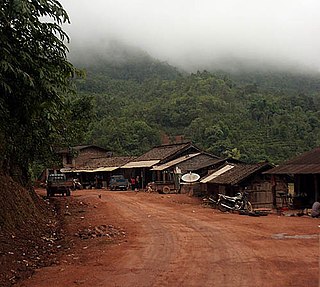Related Research Articles

Xishuangbanna, Sibsongbanna or Sipsong Panna, shortened to Banna, is an autonomous prefecture for Dai people in the extreme south of Yunnan Province, China, bordering both Myanmar and Laos. The prefectural seat is Jinghong, the largest settlement in the area and one that straddles the Mekong, called the "Lancang River" in Chinese.

The Blangpeople are an ethnic group. They form one of the 56 ethnic groups officially recognized by the People's Republic of China.

Yiwu is a town in Mengla County, Xishuangbanna prefecture, Yunnan province, China, bordering Laos's Phôngsali to the east.

Lancang Lahu Autonomous County is an autonomous county under the jurisdiction of Pu'er City, in southwestern Yunnan province, China. Lancang is the same as Lan Xang, and refers to the Mekong River on its eastern borders and adopted by modern Laos, a Tai word meaning Million Elephants.
Akha is the language spoken by the Akha people of southern China, eastern Burma, northern Laos, and northern Thailand.
Bit is an Austroasiatic language spoken by around 2,000 people in Phongsaly Province, northern Laos and in Mengla County, Yunnan, China.

Jiangcheng Hani and Yi Autonomous County is an autonomous county under the jurisdiction of Pu'er City, in southern Yunnan, China, bordering Laos and Vietnam to the south, making it the only county in the province to border more than one country. By road, its seat, the town of Menglie (勐烈镇), is 520 km (320 mi) from Kunming and 145 km (90 mi) from Simao District, the municipal seat of Pu'er.

Jinggu Dai and Yi Autonomous County is an autonomous county under the jurisdiction of Pu'er City, Yunnan Province, China.

Menghai County is a county under the jurisdiction of Xishuangbanna Dai Autonomous Prefecture, in the far south of Yunnan, China, bordering Burma's Shan State to the southwest. Meng is as variation of Mueang.

Mengla County is a county under the jurisdiction of the Xishuangbanna Dai Autonomous Prefecture, in far southern Yunnan province, China. Meng is a variation of Mueang.
Man Met, or Kemie, is a poorly classified Austroasiatic language spoken by about 1,000 people in Jinghong County, Xishuangbanna, China. It is classified as an Angkuic language by Paul Sidwell (2010). It may be or Mangic according to Li Yunbing (2005), or Palaungic. Like most other Austroasiatic languages, Kemie has subject–verb–object (SVO) word order.
The U language or P'uman, is spoken by 40,000 people in the Yunnan Province of China and possibly Myanmar. It is classified as an Austroasiatic language in the Palaungic branch. In China, U speakers are classified as ethnic Bulang.
Wa (Va) is an Austroasiatic language spoken by the Wa people of Myanmar and China. There are three distinct varieties, sometimes considered separate languages; their names in Ethnologue are Parauk, the majority and standard form; Vo and Awa, though all may be called Wa, Awa, Va, Vo. David Bradley (1994) estimates there are total of 820,000 Wa speakers.
Lalo is a Loloish language cluster spoken in western Yunnan, China by 300,000 speakers. Speakers are officially part of the Yi nationality, and Chinese linguists refer to it as "Western Yi" due to its distribution in western Yunnan. Lalo speakers are mostly located in southern Dali Prefecture, especially Weishan County, considered the traditional homeland of the Lalo. Historically, this area is the home of the Meng clan, who ruled the Nanzhao Kingdom (737–902 CE). Many speakers of Core Lalo dialects claim to be descendants of the Meng clan.
Tai Ya, also known as Tai Cung, Tai Chung and Dai Ya, is a Southwestern Tai language of southern China. It has one dialect, Tai Hongjin ; Red Tai.
Sangkong is a Loloish language spoken in China by the Hani people in Xiaojie Township 小街乡, Jinghong County. They are called Buxia (布夏) by the local Dai people.
The Hani languages are a group of closely related but distinct languages of the Loloish (Yi) branch of the Tibeto-Burman linguistic group. They are also referred to as the Hanoid languages by Lama (2012) and as the Akoid languages by Bradley (2007).
Cosao is a Loloish language of China and Laos. The Cosao call themselves, but are referred to by other ethnic groups as the Paijiao people (排角人). They are officially classified by the Chinese government as ethnic Hani people.
Lami is a Southern Loloish language of Yunnan, China. Lami is spoken in Jiangcheng Hani and Yi Autonomous County, Mojiang Hani Autonomous County, Jinping Miao, Yao, and Dai Autonomous County, and Honghe County. Lami is also spoken in Hade 哈德, Sanmeng Township 三猛乡, Lüchun County.
Guozuo is a Southern Loloish language of Yunnan, China. It is spoken in Jinping Miao, Yao, and Dai Autonomous County and Lüchun County, Yunnan.
References
- ↑ Akeu at Ethnologue (25th ed., 2022)

- ↑ You Weiqiong [尤伟琼]. 2013. Classifying ethnic groups of Yunnan [云南民族识别研究]. Beijing: Ethnic Publishing House [民族出版社].
- ↑ Hayashi, Norihiko. 2015. Two Akeu Dialects in Myanmar and China. Paper presented at SEALS 25, Payap University, Chiang Mai, Thailand.
- ↑ Kosonen, Tuula. 2015. Akeu numerals.
